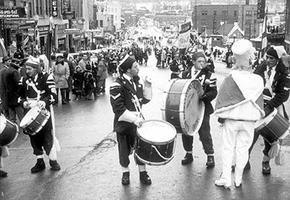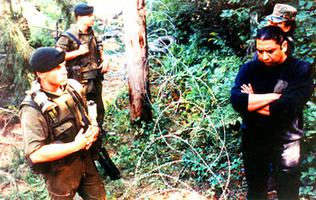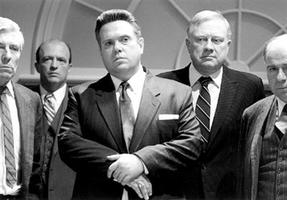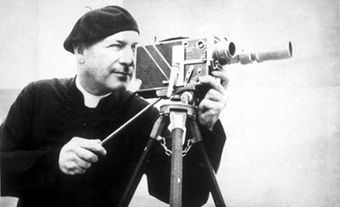Film, Documentary
The documentary genre was virtually synonymous with the National Film Board for most of the 20th century, but earlier work preceded this development and, by the late 20th century, an independent tradition of documentary filmmaking had again begun to emerge. In the first decade of the 20th century, companies such as Canadian Pacific and Massey-Harris used film for promotional purposes. The federal government established its own agency, mainly as a result of its involvement with film in World War I. From this evolved the Canadian Government Motion Picture Bureau in 1923, which for a brief time in the 1920s led the world in using film to spread information. The bureau's most notable film was Lest We Forget (1935), a documentary history of the Canadian effort in WWI compiled from newsreels, graphics and re-enacted scenes. Another successful documentary was The Royal Visit (1939), a record of the Royal Tour of that year.
In the 1930s Associated Screen News, a private film company in Montréal, produced many films and series, such as Canadian Cameo, for theatrical release. Gordon Sparling spent most of his career at ASN, and Rhapsody in Two Languages (1934) remains a classic prewar documentary. In Québec, a number of priests, notably Maurice Proulx and Albert Tessier, shot films extolling the land and Catholic virtues, documents depicting a lifestyle now disappeared.
The National Film Board
With the arrival of John Grierson, who was responsible for creating the NFB in 1939, the documentary began to flourish. The coming of war meant that Canada needed propaganda films, and series such as Canada Carries On and The World in Action reached audiences of millions. Grierson also promoted films that dealt with ethnic groups, native people, social problems and Canadian art. The arrival of peace in 1945 signalled a new direction for the NFB. By the early 1950s a group of young NFB filmmakers, part of Unit B, began to produce a unique body of work based on the Canadian experience. Corral (1954), City of Gold (1957) and Lonely Boy (1961) dealt with issues of the past and the present in a quiet, delicate fashion. The Candid Eye series, made for TV, examined socially relevant issues in The Days Before Christmas (1958) and The Back-Breaking Leaf (1959). Unit B, under Tom Daly, produced much of its work for TV in the period 1952-58 before the CBC developed its own capability.
The Independents
In the private sector, Allan King gained international repute with his cinéma-vérité films Warrendale (1967) and A Married Couple (1969). King formed his own company to produce documentaries before moving on to direct fiction features, although he returned to the form with the provocative Who's in Charge (1983). F.R. "Budge"Crawley, an Ottawa filmmaker who formed his own company (1938), won an Oscar for The Man Who Skied Down Everest (1975), the pinnacle of a long, distinguished career that also included The Loon's Necklace (1948). Harry Rasky achieved prominence with his portraits of famous people such as Marc Chagall, Will and Ariel Durant, Leonard Cohen, Arthur Miller and Anne Frank.
Women have contributed a number of highly interesting films in the private sector. Diane Létourneau looked at the role of nuns in Québec society in Les Servantes du bon Dieu (1979), while Luce Guilbeault examined women at home in D'abord menagères (1978). The producer/director team of Janis Cole and Holly Dale in Toronto made a number of key documentaries: P4W - Prison for Women (1981) and Calling the Shots (1988).
Regional filmmakers began to make their own distinctive contributions: on the West Coast, Phillip Borsos with his film Nails (1979); on the Prairies, Tom Radford with China Mission (1980) and Anne Wheeler with War Story (1982); Michael Scott with For Gentlemen Only (1976) and Bob Lower with Something Hidden (1981) from Winnipeg; and Kent Martin with Empty Harbours, Empty Dreams (1979) from Halifax. Québec began to reassert its documentary prowess in the late 1970s and made films about its music (Le Son des français d'Amérique series, 1973-77), Indians (Carcajou et le péril blanc series, 1973-76), its heritage (La Belle Ouvrage series, 1977-80), deprived people (Les Exclus series, 1978) and daily life (Chronique de la vie quotidienne series 1973-78).
Even after television's influence on documentary came to dominate the genre, Canadian filmmakers continued to produce fine examples of the form. Ron Mann began his career with two films on jazz and poetry, Imagine the Sound (1981) and Poetry in Motion (1982). Brigitte Berman made two films on great American jazz and blues artists: the trumpeter Bix Beiderbecke in Bix: "ain't anybody play like him yet" (1981) and Artie Shaw: Time Is All You've Got (1985), a film on the famous American clarinetist that won the Academy Award for Best Documentary Film. John Walker produced a fine film on the great American photographer Paul Strand entitled Strand (1989).
Severe cutbacks in funding to the NFB in the last decades of the 20th century opened the field to independents. The work is as diverse as the filmmakers. On the West Coast, Nettie Wild made two political documentaries: A Rustling of Leaves (1990), which deals with the guerilla war in the Philippines, and Blockade (1993), a film about logging in BC. Simcha Jacobovici examined his Jewish heritage in Falasha: Exile of the Black Jews (1983), Deadly Currents (1991) and Hollywoodism (1997).
Peter Wintonick and Mark Achbar concentrated on the media commentator Noam Chomsky in Manufacturing Consent (1992). Aerlyn Weissman and Lynne Fernie took an affectionate look at lesbian history in Forbidden Love (1992); Katherine Gilday probed the world of eating disorders in The Famine Within (1990), while Janis Lundman and Adrienne Mitchell turned their cameras on teenagers in Talk 16 (1991). Peter Mettler has moved with equal ease between fiction and documentary. His film documenting one of Robert LePage's plays, Tectonic Plates (1992), is far more than a simple transcription of a stage play, while the luminous Visions of Light (1994) captures the elusive phenomenon of the northern lights. Rhombus Media has carved out a niche by producing a number of very fine documentaries on art and music; their best-known film Thirty-Two Films About Glenn Gould (François Girard, 1993) is a fictionalized portrait of the great pianist.
Some filmmakers have mixed dramatized recreations into their documentaries. While this was relatively commonplace in many films of the 1950s, the cinema- vérité movement of the 1960s forced many filmmakers to move in a direction of trying to represent reality as accurately as they could. By the 1970s filmmakers were much more willing to mix the two again. Donald Brittain increasingly explored this avenue towards the end of his career with great success; a good example is his film Volcano: An Enquiry Into The Life And Death Of Malcolm Lowry (1976). Richard Boutet mixed documentary and cabaret in his fine look at Québec in WWII, La guerre oubliée (1988).
Three trends characterized Canadian documentary filmmaking during the final decade of the 20th century and the beginning of the 21st: a shift from film to video at the NFB; a perceptible move away from Griersonian ideals of pedagogy and social utility; and the emergence of a distinct, aboriginal cinematic voice.
By 2000 the NFB was making few films in 16 mm, shooting almost everything on cheaper video format. While widespread use of small video cameras has liberated documentary much as lightweight 16 mm cameras did in the 1950s and 60s, it has also changed the photographic aesthetic that made the NFB internationally respected. The cheapness and simplicity of video, as compared with the expensive and technically demanding format of 16 mm film, has been said to encourage aesthetic laziness or carelessness. The shift to video is made apparent in Peter Wintonick's film Cinéma Vérité: Defining the Moment (1999), which features shot- on-video interviews with NFB veterans like Michel Brault and Colin Lowe alongside clips from their films. This juxtaposition of interview and film clips gives the documentaries a lush, vivid feel that makes them stand out alongside the visually flat contemporary interviews.
Many Canadian filmmakers of the 1990s have rejected Grierson's belief in the instrumentality of documentary film and moved away from the dry, earnest style he exemplified. Their approach to subjects is playful and sometimes mocking in a way that differentiates them from filmmakers working within the Grierson tradition. Project Grizzly (Peter Lynch/NFB, 1996), for example, is a comic and slightly mocking portrait of Ontarian Troy Hurtubise, who designed a suit of armour meant to allow him to study grizzly bears without being killed. The Powder Room (Ann Kennard/NFB, 1996) examines the intimate conversations women have with one another in public places (washrooms, saunas, dance halls). Rather than analyse or explain, as Grierson would have demanded, Kennard evokes the sense of familiarity, of confidence, that can define these situations.
The leader of this post-Grierson school of documentary is Toronto-based Ron Mann, who has founded his own production company and works separately from the NFB. Mann's films have examined the counterculture of Canada and the US, covering such topics as the Canadian publisher Coach House Press (Echoes Without Saying, 1983), comic books (Comic Book Confidential, 1988), dance crazes (Twist, 1992), Toronto's Rochdale College (Dream Tower, 1994), or the prohibition of marijuana (Grass, 1999). Using archival footage in a critical, often satirical way (clearly influenced by his mentor, American political filmmaker Emile de Antonio), Mann charts a very different course for Canadian documentary than most of his predecessors.
Aboriginal filmmakers, while still marginalized in Canadian cinema as a whole, have been responsible for some of the most interesting documentaries of the last decade. Alanis Obomsawin, who has worked at the NFB since the 1960s and produced many films, is the most prominent of this group of documentarians. Her films, along with such works as Foster Child (Gil Cardinal, 1987) and Amarok's Song: The Journey to Nunavut (Martin Kreelak, 1998), injected some much-needed passion and political awareness into Canadian documentary cinema. The emergence of an aboriginal cinema has been helped by institutions such as the NFB (especially through their Edmonton-based Studio One, in operation from 1991 to 1995) and the Banff Centre, and by television initiatives like the Inuit Broadcasting Corporation and the Aboriginal People's Television Network.
The documentary idea has unique significance in Canadian art, and most especially for Canadian cinema. Indeed, the realist tradition dominates even our fictional cinema. Perhaps its roots can be traced to a number of sources. This distrust of the "imaginary" and the irrational could have arisen out of a utilitarian philosophy that provides the cornerstone for our educational and social system. Others feel that the documentary form is rooted in a need to comprehend the alien and hostile landscape that surrounds us. Grierson's philosophy, which had a great influence on documentary film in Canada, was essentially educative and informative. He wanted to bridge the gap between people by showing them how others lived. This pragmatic approach found its natural form in the factual or documentary film.
French Film
In 1956 the NFB moved from Ottawa to Montréal and provided great incentive to French-Canadian production. The French Unit made socially active films of commitment and contestation. In direct cinema, which relies on portable, lightweight 16 mm cameras and magnetic sound-recording equipment, the director does not preplan but allows events to dictate the direction of the finished film. This direct cinema movement produced classics in Québec such as Les Raquetteurs (1958) and La Lutte (1961). The feature documentary Pour la suite du monde (1963) captured the vanishing lifestyle of islanders in the St Lawrence. Its directors, Pierre Perrault and Michel Brault, went on to make outstanding contributions to the Québec documentary film. By the late 1960s the material emerging from French production at the NFB took on a more political bias; Denys Arcand's film on the cotton industry, On est au coton (1970), was banned, before he went on to examine numerous facets of politics in Québec: Duplessis et après... (1972).
English Film
The anglophone filmmakers at the NFB steered away from making overtly political films and tended to concentrate on individuals. Donald Brittain carved out a memorable 30-year career. He rose to the fore with Memorandum (1965) and followed this with numerous finely crafted films, many of which used archival footage. As his career progressed he began to mix found footage with dramatized material in films like Canada's Sweetheart: The Saga of Hal C. Brooks (1985).
Numerous other filmmakers produced excellent work of a diverse nature at this time: Don Owen, Robin Spry and Tony Ianzelo, to mention a few. More personal and inquiring works were made by people such as Derek May and Michael Rubbo. May made some superb art documentaries, but his film about his marriage to a Québec actress, Mother Tongue (1979), caught the dilemmas of the two cultures - English and French - that found themselves at loggerheads in this period as Québec underwent a series of referendums on its future. Rubbo travelled farther afield, making films situated in Indonesia, Cuba, Australia and France. His film on Vietnam, Sad Song of Yellow Skin (1971), won the prestigious Robert Flaherty Award.
The NFB began to revitalize itself in the 1970s through a new program entitled "Challenge for Change," which had an overt social and political function. This program produced some of Canada's finest documentaries. Another fortuitous development resulted from the "Challenge for Change" program: the establishment of a women's studio at the NFB in 1974. Studio D has produced a number of fine works on a variety of problems from a woman's perspective. Its most controversial effort was its film on pornography, Bonnie Sherr Klein's Not a Love Story (1981). Terre Nash won an Academy Award for If You Love This Planet (1982). Gail Singer emerged with a number of fine films, Abortion: Stories from North and South (1984) and Wisecracks (1991, made independently) being two of her best. Québec women filmmakers also had an illustrious history at the NFB. Anne-Claire Poirier has made a number of feature documentaries; her film on rape, Mourir à tue-tête (1979), garnered many accolades, as has her film on the death of her daughter, Tu a crié/Let Me Go (1997). Studio D was closed in 1996.
The tradition of the socially aware documentary continued to have advocates at the NFB. Paul Cowan's Democracy on Trial: The Morgentaler Affair (1984) and Justice Denied (1989) were films that dealt with issues of abortion and justice. Sturla Gunnarsson's Final Offer (1985) was a riveting cinema-verité documentary about the striking autoworkers. Alanis Obomsawin, a native filmmaker, has become one of the NFB's most distinguished creators. Her heartbreaking Richard Cardinal: Cry from the Diary of a Métis Child (1986) established her credentials while Kanehsatake: 270 Years of Resistance (1993) is a mesmerizing look at the standoff between the Mohawk and the Québec police and Canadian army over land rights.

 Share on Facebook
Share on Facebook Share on X
Share on X Share by Email
Share by Email Share on Google Classroom
Share on Google Classroom






